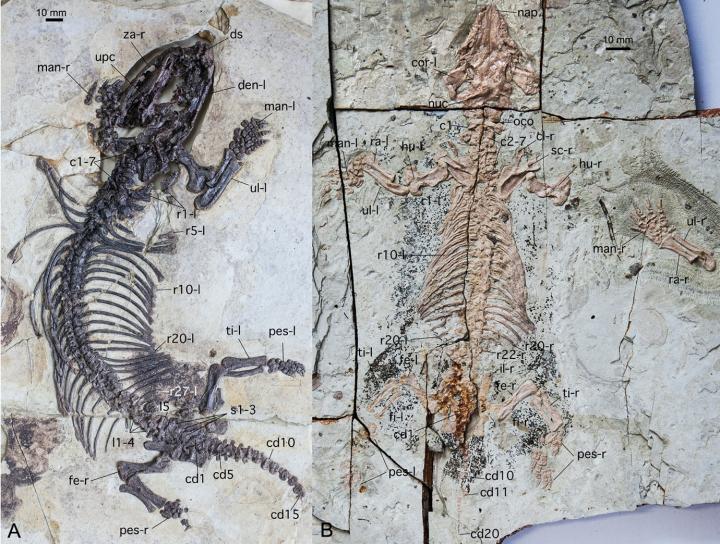120-million-year-old animals evolved ‘scratch digging’ traits independently

Credit: MAO Fangyuan
A joint research team led by Dr. MAO Fangyuan and Dr. ZHANG Chi from the Institute of Vertebrate Paleontology and Paleoanthropology (IVPP) of the Chinese Academy of Sciences and Prof. MENG Jin from the American Museum of Natural History have discovered two new species of mammal-like, burrowing animals that lived about 120 million years ago in what is now northeastern China.
The new species, described in Nature on April 7, are distantly related. However, they independently evolved traits to support their digging lifestyle. They represent the first “scratch diggers” discovered in this ecosystem.
“There are many hypotheses about why animals dig into the soil and live underground,” said Prof. MENG, lead author of the study. “For protection against predators, to maintain a temperature that’s relatively constant, or to find food sources like insects and plant roots. These two fossils are a very unusual, deep-time example of animals that are not closely related and yet both evolved the highly specialized characteristics of a digger.”
The fossil mammaliamorph species–predecessors to mammals–were discovered in the Jehol Biota, which represents the Early Cretaceous epoch, about 145 to 100 million years ago.
One is a mammal-like reptile called a tritylodontid and represents the first of its kind to be identified in this biota. About a foot in length, it was named Fossiomanus sinensis. The other one, Jueconodon cheni, is a eutriconodontan, a distant cousin of modern placental mammals and marsupials, which were common in the biota. It is about seven inches long.
Mammals that are adapted to burrowing have specialized traits for digging. The researchers found some of these hallmark features, including shorter limbs, strong forelimbs with robust hands, and a short tail, in both Fossiomanus and Jueconodon. In particular, these characteristics point to a type of digging behavior known as “scratch digging,” accomplished mainly by the claws of the forelimbs.
“This is the first convincing evidence for fossorial life in those two groups,” said Dr. MAO. “It also is the first case of scratch diggers we know about in the Jehol Biota, which was home to a great diversity of animals, from dinosaurs and insects to plants.”
The animals also share another unusual feature: an elongated vertebral column. Typically, from the neck to the hip, mammals have 26 vertebrae. However, Fossiomanus had 38 vertebrae–a staggering 12 more than the usual number–while Jueconodon had 28.
To try to determine how these animals got their elongated axial skeleton, the paleontologists turned to recent studies in developmental biology, finding that the variation could be attributed to gene mutations that determine the number and shape of the vertebrae during early embryonic development of these animals. Variation in vertebrae number can be found in modern mammals as well, for example, in elephants, manatees, and hyraxes.
###
This study was supported by the National Natural Science Foundation of China, the Chinese Academy of Sciences Strategic Priority Research Program, the Youth Innovation Promotion Association, and the Kalbfleisch Fellowship of the American Museum of Natural History’s Richard Gilder Graduate School.
Contact: PhD candidate at the Faculty of Medicine, University of Bergen, Einar Marius Hjellestad Martinsen – e-mail – [email protected] – cell phone – +4797788414
Media Contact
MAO Fangyuan
[email protected]
Related Journal Article
http://dx.




